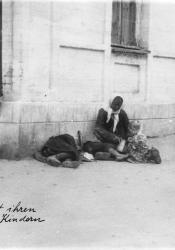Holodomor: Man-made Famine
Conflict between Ukraine and Russia has, as we see in this timeline, extended over hundreds of years, and while many events within this conflict are known throughout the world, some events, such as the Holodomor, are not commonly known by those who did not experience it. “The Psychological Consequences of the Holodomor in Ukraine” by Viktoriia Gorbunova and Vitalii Klymchuk” (2020) mentions,“The Holodomor has been recognized in more than 20 countries around the world as an attempt to eliminate the Ukrainian people” (4), so why is it not known throughout the world? In the 1930s, Russia was known as the Union of Soviet Socialist Republics (USSR), and Ukraine was under its control. The leader of the USSR at this time was Joseph Stalin, and he feared that Ukraine was strengthening itself in a manner that would eventually lead to its independence from the USSR. To prevent Ukraine becoming an independent country or nation, Stalin was determined to put down any revolution before it could start, and his plan was put into place through enacting collectivization.
The collectivization of Ukraine meant that Ukrainian farmers had to surrender control of their land, produce, animals, and labor to the Soviet government. With the control over Ukrainian farming and produce, the USSR with Stalin as its leader created a man-made famine in Ukraine by taking harvests the harvests of the Ukrainian people, leaving them with little food. In the early 1930s in Ukraine, many farmers and rural villagers relied on crops to help feed their families. Subsistence farming was a common way of life within the country. So, when complete access to these crops was taken away by Stalin and the USSR, the farmers and villagers were not able to obtain enough food to keep themselves from starvation. According to “Holodomor” from the University of Minnesota, “The primary victims of the Holodomor were rural farmers and villagers, who made up roughly 80 percent of Ukraine’s population in the 1930s” (1). With such a large percent of the population being those directly affected by the man-made famine, one can only begin to understand how many individuals were likely killed and the suffering many endured. While there are not many well-known accounts of the lived experiences of the Holodomor, one man, Wasyl Kushnir, emphasizes the reality of this event in by sharing his experience in Epic Journey: The Life and Times of Wasyl Kushnir through the following description: “People sat and lay at the foot of buildings and in the streets, under bridges, swollen from hunger, mostly small children and older men of all ages, dying from hunger, so swollen that they could not walk” (19). This eye-opening description helps one understand the suffering of many in Ukraine at the hands of Stalin and the USSR; however, while this suffering was created by a man-made famine on behalf of the USSR, the USSR attempted to blame the famine on individuals within Ukraine.
In an article from London’s The Times in 1933, the following statement is made after hearing a speech from a USSR representative known as M. Postyscheff: “He accuses the Separatists of having organized starvation in the Ukrainian order to breed discontent and make the Soviet System unpopular” (2). This article emphasizes something still prevalent today: the false counternarrative created by Russia—the USSR in this case—against the narrative of those they try to control. In 1933, Ukraine was suffering and starving because of USSR decisions and practices; however, the USSR blamed the famine and starvation on separatists—those wishing for Ukrainian independence. This counternarrative attempted to portray those seeking independence as the enemy to keep individuals loyal to the USSR; however, suffering Ukrainians knew the truth. Today, Russia is still attempting to use propaganda and false narratives to keep its people loyal and submissive. Especially regarding its current attack on Ukraine, Russia has pushed out false stories and realities to justify its acts to the Russian people and eliminate potential resistance for their plans and agenda. In comparing the Holodomor and Russia’s current attack on Ukraine, it becomes easier to see recognize that Russia’s desire to control Ukraine has never subsided, and history repeats itself in various ways.
Works Cited:
“Holodomor.” University of Minnesota: College of Liberal Arts, https://cla.umn.edu/chgs/holocaust-genocide-education/resource-guides/ho...
Kushnir, Andrei. “The Holodomor.” Epic Journey: The Life and Times of Wasyl Kushnir, Academic Studies Press, 2020, pp. 16–19, https://doi.org/10.2307/j.ctv1z3hm1c.10. Accessed 27 Apr. 2022.
Gorbunova, Viktoriia, and Vitalii Klymchuk. “The Psychological Consequences of the Holodomor in Ukraine.” East/West: Journal of Ukrainian Studies, 26 Oct. 2020, https://ewjus.com/index.php/ewjus/article/view/609.
OWN, OUR. "Ukrainian Separatism." Times, 12 Dec. 1933, p. 13. The Times Digital Archive, link.gale.com/apps/doc/CS220014988/TTDA?u=iulib_iupui&sid=bookmark-TTDA&xid=113f5664. Accessed 27 Apr. 2022.
Wienerberger, Alexander. “Mother with Her Starving Children.” RFERL.org, Kharkiv, 8 May 2021, https://gdb.rferl.org/0AFC7EF1-E4FE-427D-A257-671243E50AAC_w1023_r0_s.jpg. Accessed 30 Apr. 2022.
Related Links
https://editions.covecollective.org/chronologies/black-panthers
Alaina's timeline entry on the Black Panthers emphasizes the use of false narrative on behalf of the government to portray the Black Panthers in a negative light. This creation of a false narrative relates to the false narratives Russia has created about Ukraine for years, including in 1933 during the Holodomor and 2022 within the current conflict.
https://editions.covecollective.org/chronologies/russian-invasion-ukraine
Truitt's entry on the most recent Russian invasion of Ukraine is a climactic event resulting from events and ideaologies such as the ones mentioned in this entry.

